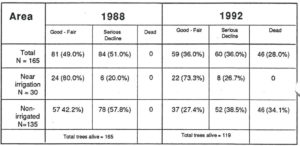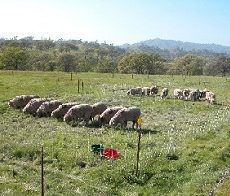Oaks ‘n’ Folks – Volume 8, Issue 2 – November 1993
Many recommendations concerning irrigation of established native California oak trees caution against summer water application, especially near the base of the tree. Fungal diseases such as oak root fungus (Armillaria mellea) and crown rot (Phytophthora spp) are often associated with the death of oak trees under conditions of high soil moisture. Even though oaks are known to be drought tolerant, summer irrigation may be beneficial to oak trees, especially during period of prolonged drought, if water is kept at least 3 m (10 ft.) away from tree root crowns, or applied in the outer two-thirds of the root zone.
The purpose of this study was to test the validity of these recommendations and to present findings on the effects of summer irrigation on established oak trees.
Methods
Trial 1
A group of 165 native valley oak trees (Quercus lobata Nee), growing in Oak Grove Regional Park near Stockton, California, were evaluated in 1988 using an oak tree hazard evaluation system that included an objective measure of tree vigor. The trees had an estimated average age of 125 years based on a sampling of increment borings. The soil type in the park is a clay loam with a dense, root limiting calcareous layer at 35 cm (14 in). As a result of this relatively shallow soil the trees have developed extensive but shallow root systems. Therefore, these trees may be more prone to water stress during periods of drought.
The average density of trees was 50 per hectare (20/ac) and they were fairly evenly distributed throughout the test area. The region is currently experiencing a drought, with winter rainfall averaging only 58 percent of normal for the last six years.
The park was first developed in 1978, with sections designated either as landscaped or as natural areas. The landscaped areas received regular summer irrigation from sprinkler systems. The irrigation was applied between the months of March and October, four times per week at 45 minutes per irrigation. Water application rates were 5 cm (2 in) per week, approximating evapotranspiration (ETo).
The natural areas were not irrigated. However, the root systems of some of the trees in the natural area extended into the landscaped areas and therefore received summer irrigation.
To study the effect of summer irrigation on these oaks, the trees were re-evaluated in 1992. Thirty trees located in the unirrigated natural area were near irrigation, being with 2X dripline of the landscaped areas, and therefore received some irrigation water. The other 135 trees did not receive summer irrigation water.
Trial 2
A group of 24 native valley oaks were selected to study the effects of irrigation on improving vigor on drought-stressed trees. All trees were in non-irrigated areas of the same park and had generally poor vigor. Twelve trees received drip irrigation approximately 2 m (6 ft) from the trunk at the average rate of 0.25 cm (0.10) per hour for 30 hours in mid-July. Soil moisture sensors (Watermark, Irrometer Co.) were placed in the soil at a depth of 35 cm (14 in), the depth to hardpan in the park. Irrigation continued until adequate moisture, measured as 10 centibars, was detected at that depth. The other 12 trees did not receive supplemental irrigation.
Results
Trial 1
By 1992, 73% of the non-irrigated trees were in serious decline or dead. Significantly fewer, only 27%, of the trees near irrigation were in a similar condition. Root sampling in the area for disease did not show the presence of damaging pathogens, and no significant levels of insect pests above ground were found.

Trial 2
Results of the drip irrigation trial showed signs of improved tree growth by mid-August, four weeks after the application of supplemental irrigation (Table 2). Eight of 12 (67%) irrigated trees showed signs of new shoot growth ranging from 5 – 31 cm (2-12 in.) in length. The 12 trees not receiving supplemental irrigation showed no signs of new shoot growth. After five weeks, 11 of 12 (92%) irrigated trees had new growth, while only 2 (17%) of the non-irrigated trees showed similar growth.

One year after irrigation, 83% of the irrigated trees continued to show improved vigor over the 1988 ratings. Significantly fewer of the non-irrigated control trees showed an improved vigor. Only 8% of these trees in 1992 had an improved vigor rating since the 1988 evaluation, and 92% showed no change or had declined.
Conclusions
Under periods of prolonged drought, supplemental irrigation of established oak trees may prevent their decline and death. If irrigation water is applied ell away from the tree root crown area but with the tree rooting zone, even frequent summer water application may not be detrimental to established oak trees.
prepared and edited by John M. Harper, Richard B. Standiford, and John W. LeBlanc

